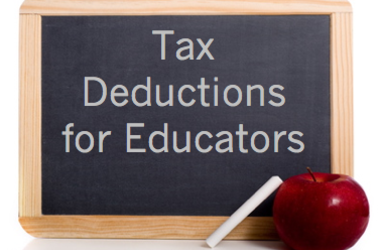Accounting
Tax Deduction For Teacher Expenses Made Permanent
The deduction is available for more than just art supplies, videos and the like. The definition of “qualified expenses” also encompasses other supplies, books, computer equipment (including related software and services), other equipment and ...
Jan. 19, 2016

[The new “extenders law” enacted late in 2015 retains several key tax provisions and makes them permanent with certain modifications. This is the sixth part of a series of articles on these tax breaks.]
Congress is rewarding teachers and other educators who put their money where their mouths are.
If you go “above and beyond the call of duty” and pay classroom costs out of your own pocket, the new tax law – the Protecting Americans from Tax Hikes (PATH) Act of 2015 — allows you to write of up to $250 of the qualified expenses. Although this tax provision technically expired after 2014, the PATH Act restores it retroactively to 2015 and makes it permanent. What’s more, the new law indexes the $250 deduction to inflation for 2016 and thereafter.
The deduction is available for more than just art supplies, videos and the like. The definition of “qualified expenses” also encompasses other supplies, books, computer equipment (including related software and services), other equipment and supplementary materials used in the classroom. For courses in health and physical education, expenses count as qualified expenses only if they’re related to athletics.
The PATH Act further enhances the deduction by allowing “professional development expenses” to qualify. Professional development expenses cover courses related to the curriculum in which the educator provides instruction. This enhancement applies to tax years beginning after 2015.
Note that the deduction isn’t strictly limited to teachers. The IRS says you can deduct classroom expenses on your 2015 return if you were employed for the tax year at a state-approved public or private school system and held one of the following positions for kindergarten through grade 12:
• Teacher
• Instructor
• Counselor
• Principal
• Aide
To qualify, you must work at least 900 hours a school year in a school providing elementary or secondary education as determined by state law. If a couple shares a career in education, they may double up on the deduction for up to $500 a year on a joint return, but each spouse is limited to $250 of qualified expenses. For example, if a husband spent $100 on school supplies and the wife spent $400, the amount attributable to the wife is still limited to $250 for a total of $350.
Notably, the deduction for teacher classroom expenses is claimed “above the line,” so it’s more valuable than a regular deduction. First, non-itemizers, as well as itemizers can claim it. Second, it can lower your adjusted gross income (AGI) slightly for other tax return purposes. Without this write-off, teachers previously could only deduct unreimbursed expenses as miscellaneous expenses subject to a floor of 2 percent of AGI. If expenses didn’t exceed the 2 percent mark, they could not deduct any of these expenses.
Don’t forget that the excess above the annual $250 threshold still counts toward the miscellaneous expense deduction if you otherwise qualify. For instance, if a client spent $1,000 on classroom expenses in 2015 and clears the 2 percent-of-AGI hurdle with other miscellaneous expenses, he or she can deduct $250 as a teacher classroom expense and an extra $750 as a miscellaneous expense on Schedule A.
